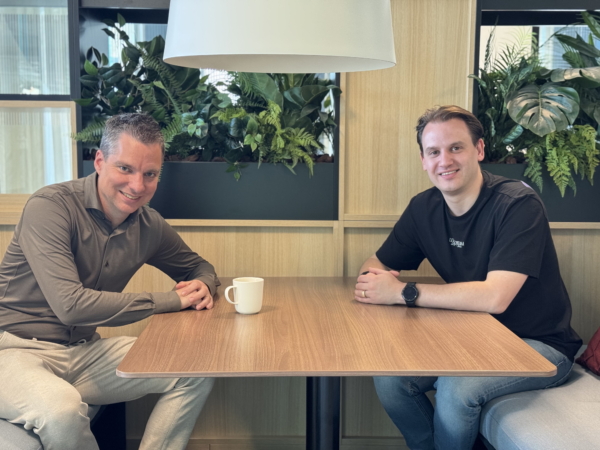
Data
Why data management is urgent for your organization Optimal data protection or the development of…
Read more

Generative AI (GenAI) is rapidly changing the way we work. Those who know how to use GenAI effectively work faster, smarter, and more accurately, whether they are developers, analysts, or consultants.
But what does that require? Which skills will be indispensable in the future? Data and GenAI experts Ton Godtschalk and Jeroen Egelmeers at Capgemini Academy see it in practice every day. “You don’t have to be a software engineer to reap the full benefits of GenAI. Other professionals can also benefit greatly from it.”

The conversation with Jeroen Egelmeers and Ton Godtschalk begins in a relaxed manner via Teams. They know each other from workshops, client projects, and substantive sessions at Capgemini Academy. There’s laughter about SEO buzzwords and odd prompts – things they often run into in their daily work.
But the interview quickly shifts to the topic at hand: how AI is changing work and what that requires of professionals.
As the lead of training services at Capgemini Academy, Ton Godtschalk is responsible for Capgemini’s entire training portfolio and develops strategic training offerings in areas such as AI, cloud computing, and data science. He considers the big picture and translates technological trends into concrete learning pathways.
Jeroen Egelmeers brings those programs to life. He gives training courses on prompt engineering, speaks at conferences, and works with a wide range of target groups. Jeroen says, ”We complement each other without it ever feeling like we’re working in separate boxes.”
How are you involved in AI at Capgemini Academy?
“I’m a software engineer by trade,” says Jeroen. “When GenAI emerged, I quickly saw how much of an impact it would have on the profession. Now, I teach training courses on prompt engineering and practical AI applications. I work with people from all corners of IT, as well as with young people acquiring new skills through a social return program. For me, it’s all about applicability. How can people benefit from this technology?”
Ton: “I’m responsible for the training portfolio at Capgemini Academy, covering everything from data to AI and cybersecurity. That means not only providing training but also listening to the market. What’s going on with customers? What skills are needed? How do we translate that into relevant, future-oriented training?”
Ton and Jeroen met during an innovation day. “We were both giving workshops, Jeroen on prompt engineering and me on data,” says Ton. “When I heard how he had participants practice with realistic prompts and concrete use cases, I immediately thought, “We have to do this on a larger scale.”
GenAI is a hot topic. Do you see that in its adoption as well?
Jeroen says, “GenAI is not as widespread as you might think. I sometimes stand in front of rooms filled with hundreds of people and ask who already works with GenAI. Surprisingly few hands go up. So, yes, everyone has heard of it, but not everyone is doing anything with it yet. Meanwhile, fields such as writing, software development, and marketing are changing at a rapid pace.”
Ton: “You see the same gap in organizations. They feel that something needs to be done—that GenAI is influencing their work processes, services, and people. But the question often arises: ‘Where do you start?’ How do you properly train people? How do you ensure they apply what they’ve learned? Capgemini helps with that by offering training courses that combine content and application.”
For the record, what are we actually talking about when we talk about GenAI?
Ton: “GenAI stands for generative artificial intelligence, or technology that can create new output based on large amounts of data. Think of text, code, images, or summaries. This is a significant departure from traditional AI, with which we’ve been familiar for some time. Traditional AI analyzes, recognizes, or classifies. GenAI is creative and therefore more versatile, even outside of IT.”
“It’s also much more accessible,” adds Jeroen. “You don’t need a technical background. Anyone who can give clear instructions can work with it. This difference — its power and accessibility — means the work of many professionals will change dramatically.”
Ton recognizes this pattern: “There’s also a fear of the unknown. People wonder if they’re submitting sensitive information or doing something wrong. That doubt makes them prefer to stick to their old ways. But you only really reap the benefits when you learn how to incorporate GenAI into your daily work and practice regularly.”
We’ll discuss that radical change in a moment, but first, let’s address the initial question: What is preventing people from getting started?
Jeroen explains, “Many people don’t know what GenAI can do or how to apply it effectively in their work. They try it once, find the results mediocre, and then abandon it.”
“But you really need to invest in the basics. A good prompt—a clear instruction to the AI—makes a world of difference. The model you choose also matters. For example, ChatGPT is strong in language, while GitHub Copilot is better for programming. Once people realize this, they continue to use it enthusiastically.”
Therefore, if you really want to use GenAI effectively, there’s more to it than just trying it out. What skills do you need?
Jeroen says, “It starts with being able to give clear instructions. Many people ask GenAI a question, but they do so vaguely. You need to be specific. What does the system need to do? In what style? For whom? And under what conditions? We call this prompt engineering, and it’s a skill in itself.”
Ton: “It also requires critical thinking. You need to be able to assess and adjust GenAI’s output, as well as recognize when it’s better not to use it. Experience in your own field is crucial because only then can you recognize if the content is correct. So, it’s not just about technology, but also analytical and language skills and professional knowledge.”
What does it mean for other skills if we all start prompting more often?
Ton says, “If prompting becomes a regular part of more people’s work, the necessary skills will automatically change. You don’t have to code or develop technical solutions yourself, but you need to know how to provide direction, assess results, and critically reflect on them.”
“There will be less digging into technology and more focus on the application. That requires an overview, analytical skills, and the courage to experiment, regardless of your role or position.”
You mentioned that you mainly learn GenAI by practicing and repeating it regularly. What else helps?
“Start with a job you have to do anyway,” says Jeroen. “Writing a report, holding a brainstorming session, making a plan, or preparing an analysis — let GenAI take care of it. You’ll immediately see what it adds and where it falls short.”
Ton also recommends sharing experiences with colleagues. “Show what you’ve tried, which prompts worked, and what could be improved. By doing this together, you’ll build a routine more quickly — and gain confidence more quickly.”
Are these the skills of the future?
“Definitely,” says Ton. “But there’s more. It’s also about being able to adapt to technological developments because they happen at lightning speed. It’s about knowing what’s going on, staying curious, and daring to experiment. This applies not only to developers but also to analysts, consultants, project leaders, and so on.”
Jeroen sees this reflected in how Capgemini Academy’s training courses are evolving. “In the past, the emphasis was mainly on substantive knowledge or technical expertise. Now, it’s increasingly about adaptability. How quickly can you learn to use new tools and apply them to your work? This agility is becoming a core skill.”
How does the Capgemini Academy support professionals in this regard?
“We are developing more training courses that focus on GenAI, ranging from introductory courses to in-depth sessions for specific target groups,” says Ton. “It’s equally important that we critically examine existing training courses and determine where we can integrate AI. For example, in a writing course, we use prompts to quickly get to the heart of the matter, and in data courses, we use Microsoft Copilot to generate data models. This makes GenAI relevant for every context.”
Jeroen adds, “We also offer resources for continued GenAI practice, including inspiration sessions, practical workshops, and formats you can apply to your work. This way, it won’t just be something you see once; it’ll be something you can really work with.”
Great. So how do you make sure you stay ahead – as a trainer or as an organization?
“Standing still is not an option,” says Ton. “At Capgemini, we closely follow technological developments, for example, through our international AI teams. We translate those insights directly into the Capgemini Academy curriculum. This enables us to respond quickly to current developments and prepare our customers and colleagues for what’s coming.”
Jeroen adds, “We can only maintain that lead if we continue to experiment ourselves. I’m constantly testing new tools, models, and working methods in my own work. I incorporate that knowledge into the training courses. This ensures that what we offer is not only up to date but also effective!”
Would you like to discover what GenAI can do for your work and learn how to get started? Capgemini Academy is happy to help. If you’re looking for a suitable training course or a customized program for your team, please contact us for advice.